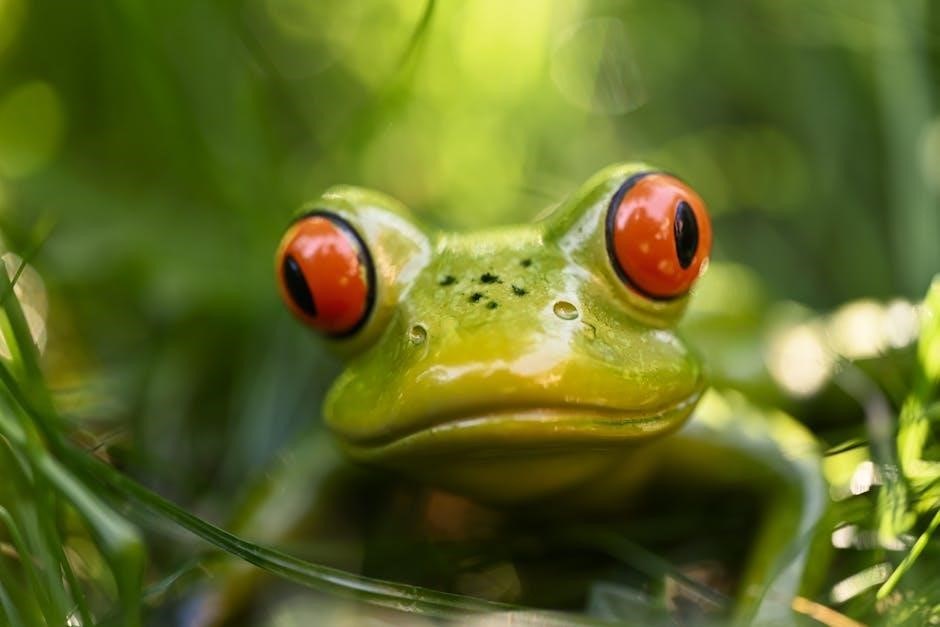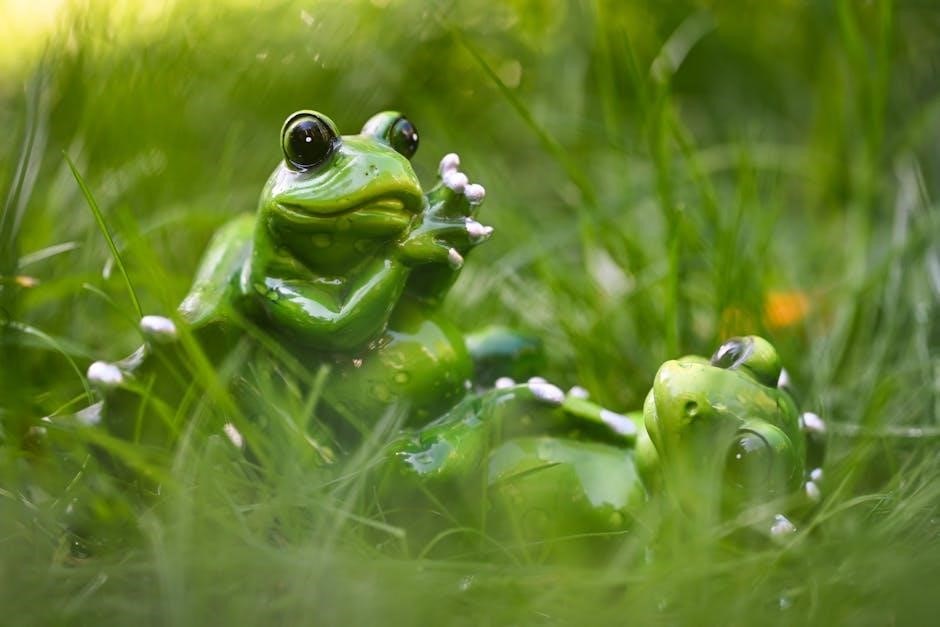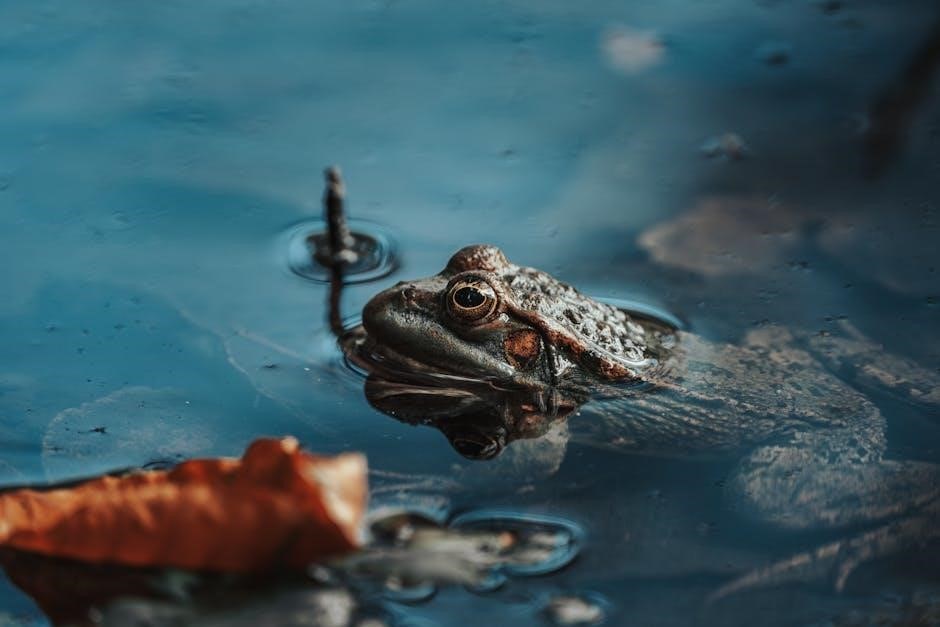Frog dissection is a fundamental biology lab activity, offering hands-on learning about anatomy and physiological systems. It enhances understanding of vertebrate biology and evolutionary connections to human systems.
1.1 Importance in Biology Education
Frog dissection is a cornerstone of biology education, providing students with hands-on experience in anatomy and physiology. It bridges theoretical knowledge with practical observation, enhancing understanding of vertebrate structures and their functions. This lab activity fosters critical thinking, scientific inquiry, and appreciation for evolutionary biology. By examining external and internal anatomy, students gain insights into organ systems and their interconnections. Frog dissection also prepares learners for advanced studies in medicine and zoology, making it a vital tool in developing scientific skills and curiosity.
1.2 Objectives of the Worksheet
The frog dissection worksheet aims to guide students in identifying and understanding external and internal anatomy, including organ systems and their functions. It helps develop observation, recording, and critical thinking skills. The worksheet ensures students can locate structures like the liver, heart, lungs, and reproductive systems. It also encourages comparisons between frog anatomy and human biology, fostering deeper insights into evolutionary connections. By completing the worksheet, students demonstrate their understanding of biological concepts and prepare for further studies in life sciences. This tool is essential for structured learning and assessment.
Materials Needed for the Dissection
- Preserved frog specimen
- Dissection tray
- Scalpel or dissection scissors
- Forceps
- Magnifying glass or microscope
- Gloves
2.1 Essential Tools and Supplies
The following materials are necessary for a successful frog dissection: a preserved frog specimen, a dissecting tray, scalpel or dissection scissors, forceps, magnifying glass or microscope, and gloves. Additional supplies include paper towels, disposable gloves, and hand lenses for magnification. Ensure all tools are sterilized and within reach. A microscope is optional but recommended for detailed organ examination. Proper arrangement of supplies enhances efficiency and safety during the procedure. Always refer to the answer key for specific tool usage guidelines.

Safety Precautions
Always wear gloves and protective eyewear. Handle sharp tools carefully and avoid sudden movements. Ensure a clean, well-ventilated workspace to minimize risks during dissection.
3.1 Handling and Protective Gear
Wear disposable gloves to prevent skin contact with preservatives. Use goggles to protect eyes from chemical splashes. A lab coat or apron minimizes exposure to stains. Ensure proper handling of sharp instruments to avoid cuts. Store tools in a secure, designated area when not in use. Avoid eating or drinking during the procedure. Clean and disinfect all surfaces before and after dissection. Properly dispose of waste materials in biohazard containers. Maintain a well-ventilated workspace to prevent inhaling strong fumes from preservatives. Follow all laboratory safety protocols to ensure a safe learning environment.

External Anatomy of the Frog
The frog’s external anatomy includes its streamlined body, moist skin, and webbed limbs. Observe the eyes, nostrils, and mouth for sensory functions. Note the dorsal and ventral surfaces.
4.1 Key Features and Identification
The external anatomy of a frog includes key features that aid in identification. The streamlined body is covered with moist, smooth skin, essential for gas exchange. The limbs are webbed, facilitating swimming. The eyes and nostrils are prominent sensory organs, while the mouth is devoid of external teeth. The dorsal surface is typically darker than the ventral side, aiding camouflage. These features are crucial for understanding the frog’s adaptation to its environment and are essential for accurate identification during dissection.
Internal Anatomy
The frog’s internal anatomy includes vital organs such as the heart, lungs, liver, and stomach, which are essential for digestion, respiration, and circulation. These systems are interconnected, reflecting the frog’s adaptation to both aquatic and terrestrial environments. Understanding these structures is crucial for comprehending the frog’s biological processes and its role in ecosystems. This section provides a detailed overview of the internal organs and their functions. The internal anatomy is a key focus of the dissection process, offering insights into the frog’s physiology and evolutionary adaptations. It is a critical area of study for students to grasp the fundamental principles of amphibian biology. The internal organs are protected by the ribcage and are carefully preserved during dissection to ensure accurate observation and analysis. The liver plays a significant role in detoxification and metabolism, while the heart pumps blood through the circulatory system, supplying oxygen to tissues. The lungs are responsible for gas exchange, though frogs also breathe through their moist skin. The digestive system, including the stomach and intestines, breaks down food for nutrient absorption. These organs work harmoniously to sustain life, making the internal anatomy a fascinating subject for detailed study. The internal anatomy also reveals the frog’s unique life cycle, from aquatic larvae to terrestrial adults, highlighting its dual lifestyle. By examining the internal structures, students can gain a deeper understanding of how frogs have evolved to thrive in diverse environments. The internal anatomy section of the worksheet provides labeled diagrams and descriptions to guide students through identification and analysis of each organ. This hands-on approach ensures a comprehensive learning experience, reinforcing theoretical knowledge with practical observation. The internal anatomy is a cornerstone of frog dissection, offering valuable insights into the biology and ecology of these amphibians. The internal organs are intricately designed to support the frog’s survival, making them a focal point of scientific study. Through careful dissection and observation, students can appreciate the complexity and efficiency of the frog’s internal systems. The internal anatomy section is designed to enhance students’ understanding of amphibian physiology and its relevance to broader biological principles. The detailed examination of internal organs provides a foundation for comparative anatomy studies, allowing students to draw connections between different species. The internal anatomy of the frog is a testament to its evolutionary success, with specialized organs that enable it to adapt to various habitats. By studying the internal anatomy, students can develop a greater appreciation for the interconnectedness of biological systems and their importance in maintaining life. The internal anatomy section of the worksheet is a vital resource for students, offering clear instructions and visual aids to facilitate a thorough understanding of the subject. The internal organs of the frog are not only essential for its survival but also provide valuable lessons in anatomy and physiology. The internal anatomy is a key component of the frog dissection process, ensuring that students gain practical experience in identifying and analyzing biological structures. The internal anatomy section is carefully designed to align with educational standards, providing students with a comprehensive and engaging learning experience. The internal organs of the frog are a fascinating topic of study, offering insights into the biology and ecology of these amphibians. The internal anatomy is a critical area of focus in frog dissection, enabling students to explore the intricate details of amphibian physiology. The internal anatomy section of the worksheet is an essential tool for educators, providing structured guidance for students to achieve a deep understanding of the subject. The internal organs of the frog are a remarkable example of evolutionary adaptation, with each system playing a vital role in the frog’s survival. The internal anatomy is a cornerstone of biological education, offering students the opportunity to explore the inner workings of living organisms. The internal anatomy section of the worksheet is designed to encourage active participation and critical thinking, fostering a deeper appreciation for the natural world. The internal organs of the frog are a testament to the complexity and beauty of biological systems, making them an engaging subject for scientific inquiry. The internal anatomy is a fundamental aspect of frog dissection, providing students with hands-on experience in anatomy and physiology. The internal anatomy section of the worksheet is a valuable resource for both students and educators, ensuring a comprehensive and effective learning experience. The internal organs of the frog are essential for its growth, development, and reproduction, highlighting their importance in the life cycle of amphibians. The internal anatomy is a key area of study in biology, offering insights into the structure and function of living organisms. The internal anatomy section of the worksheet is designed to support students in achieving their learning objectives, providing clear and concise information. The internal organs of the frog are a fascinating topic of study, offering a unique perspective on the biology of amphibians. The internal anatomy is a critical component of frog dissection, enabling students to explore the intricate details of biological systems. The internal anatomy section of the worksheet is a valuable educational tool, designed to enhance students’ understanding of anatomy and physiology. The internal organs of the frog are a remarkable example of evolutionary adaptation, with each system playing a vital role in the frog’s survival. The internal anatomy is a cornerstone of biological education, offering students the opportunity to explore the inner workings of living organisms. The internal anatomy section of the worksheet is designed to encourage active participation and critical thinking, fostering a deeper appreciation for the natural world. The internal organs of the frog are a testament to the complexity and beauty of biological systems, making them an engaging subject for scientific inquiry. The internal anatomy is a fundamental aspect of frog dissection, providing students with hands-on experience in anatomy and physiology. The internal anatomy section of the worksheet is a valuable resource for both students and educators, ensuring a comprehensive and effective learning experience. The internal organs of the frog are essential for its growth, development, and reproduction, highlighting their importance in the life cycle of amphibians. The internal anatomy is a key area of study in biology, offering insights into the structure and function of living organisms. The internal anatomy section of the worksheet is designed to support students in achieving their learning objectives, providing clear and concise information. The internal organs of the frog are a fascinating topic of study, offering a unique perspective on the biology of amphibians. The internal anatomy is a critical component of frog dissection, enabling students to explore the intricate details of biological systems. The internal anatomy section of the worksheet is a valuable educational tool, designed to enhance students’ understanding of anatomy and physiology. The internal organs of the frog are a remarkable example of evolutionary adaptation, with each system playing a vital role in the frog’s survival. The internal anatomy is a cornerstone of biological education, offering students the opportunity to explore the inner workings of living organisms. The internal anatomy section of the worksheet is designed to encourage active participation and critical thinking, fostering a deeper appreciation for the natural world. The internal organs of the frog are a testament to the complexity and beauty of biological systems, making them an engaging subject for scientific inquiry. The internal anatomy is a fundamental aspect of frog dissection, providing students with hands-on experience in anatomy and physiology. The internal anatomy section of the worksheet is a valuable resource for both students and educators, ensuring a comprehensive and effective learning experience. The internal organs of the frog are essential for its growth, development, and reproduction, highlighting their importance in the life cycle of amphibians. The internal anatomy is a key area of study in biology, offering insights into the structure and function of living organisms. The internal anatomy section of the worksheet is designed to support students in achieving their learning objectives, providing clear and concise information. The internal organs of the frog are a fascinating topic of study, offering a unique perspective on the biology of amphibians. The internal anatomy is a critical component of frog dissection, enabling students to explore the intricate details of biological systems. The internal anatomy section of the worksheet is a valuable educational tool, designed to enhance students’ understanding of anatomy and physiology. The internal organs of the frog are a remarkable example of evolutionary adaptation, with each system playing a vital role in the frog’s survival. The internal anatomy is a cornerstone of biological education, offering students the opportunity to explore the inner workings of living organisms. The internal anatomy section of the worksheet is designed to encourage active participation and critical thinking, fostering a deeper appreciation for the natural world. The internal organs of the frog are a testament to the complexity and beauty of biological systems, making them an engaging subject for scientific inquiry. The internal anatomy is a fundamental aspect of frog dissection, providing students with hands-on experience in anatomy and physiology. The internal anatomy section of the worksheet is a valuable resource for both students and educators, ensuring a comprehensive and effective learning experience. The internal organs of the frog are essential for its growth, development, and reproduction, highlighting their importance in the life cycle of amphibians. The internal anatomy is a key area
5.1 Organ Systems and Structures
The frog’s internal anatomy consists of several organ systems, each with specific functions. The digestive system includes the stomach, liver, pancreas, and intestines, responsible for food breakdown and nutrient absorption. The respiratory system features the lungs and trachea, enabling gas exchange. The circulatory system, including the heart, arteries, and veins, transports oxygen and nutrients. The nervous system comprises the brain, spinal cord, and nerves, controlling movements and reflexes. These systems work together to maintain the frog’s survival and adaptation to its environment.
Step-by-Step Dissection Procedure
- Prepare the frog and tools.
- Make a ventral incision carefully.
- Explore external and internal organs systematically.
- Identify structures using the answer key.
- Dispose of waste properly after dissection.
6.1 From Preparation to Exploration
Begin by gathering all materials and ensuring the frog is properly preserved. Make a precise ventral incision, then carefully open the abdominal cavity. Gently lift and remove the skin, exposing internal organs. Identify the heart, lungs, liver, and stomach using the answer key. Proceed to explore the digestive, respiratory, and circulatory systems. Document observations and label structures as directed. After exploration, dispose of the frog and clean tools thoroughly. This systematic approach ensures a comprehensive understanding of frog anatomy.
Answer Key Overview
The answer key provides correct responses, detailed explanations, and additional resources for educators to effectively assess student understanding and guide further learning.
7.1 Structure and Usage
The answer key is organized to align with the frog dissection worksheet, providing clear, concise answers to each question and activity. It includes numbered sections, diagrams, and explanations to help students and educators track progress. The key features labeled structures, functional descriptions, and common misconceptions. Educators can use it for grading, while students can reference it for self-study. The PDF format ensures easy access and printing, making it a versatile resource for both classroom and homework settings. Proper use enhances learning outcomes and simplifies assessment processes.
7.2 Common Questions and Tips
Common questions often revolve around identifying organs, understanding functions, and interpreting diagrams. Tips include using the answer key alongside the worksheet for clarity and cross-referencing with textbook diagrams. Students should verify their answers systematically and ask educators for clarification on complex structures. Utilizing the key effectively enhances understanding and improves dissection skills. Regular review of the answer key helps reinforce learning and prepares students for assessments. Encourage active participation and thorough examination of each step to maximize educational benefits.

Comparative Anatomy
Comparative anatomy explores similarities and differences between frog and human biological systems, aiding in understanding evolutionary biology and physiological mechanisms across species.
8.1 Relations to Human Biology
Frog anatomy shares striking similarities with human biology, particularly in organ systems like the respiratory and circulatory systems. Both species possess a heart, lungs, and liver, though frogs’ systems are simpler. The digestive system in frogs mirrors human digestion, with comparable organs like the stomach and intestines; The nervous system, including reflexes and brain structure, also shows parallels. These similarities make frog dissection a valuable tool for understanding human physiology, especially in basic biology education. Studying frogs provides insights into shared evolutionary traits and functional principles across species.

Evolutionary Significance
Frogs are key subjects in evolutionary biology, showcasing adaptability and survival over millennia. Their transition from aquatic to terrestrial habitats highlights evolutionary innovation, making them vital for studying species adaptation and evolutionary processes.
9.1 Why Study Frogs?
Frogs are essential in understanding evolutionary biology due to their unique life cycle and adaptability. They bridge aquatic and terrestrial environments, offering insights into evolutionary transitions. Studying frogs reveals how species adapt to environmental changes, making them crucial for ecological and biomedical research. Their anatomy and physiology provide comparative models for human biology, aiding in medical advancements. Additionally, frogs’ diverse species highlight evolutionary strategies, making them invaluable for education and research in life sciences and conservation biology.

Tips for Educators
Enhance learning by integrating visual aids and hands-on activities, fostering student engagement and understanding of frog anatomy and dissection processes effectively.
10.1 Effective Teaching Strategies
To effectively teach frog dissection, educators should emphasize hands-on learning, encouraging students to explore and identify anatomical structures. Use the answer key PDF as a guide for accurate identification and to clarify doubts. Incorporate group work to foster collaboration and peer learning. Utilize digital tools, such as virtual dissection software, to supplement physical dissections. Provide clear, step-by-step instructions and demonstrate each procedure to ensure understanding. Incorporate formative assessments to monitor progress and address misconceptions promptly. Encourage questioning and critical thinking to deepen comprehension of frog anatomy.

Student Resources
Students can access online guides, video tutorials, and interactive diagrams to supplement their worksheet. Additional practice sheets and review materials are available for deeper understanding.
11.1 Additional Learning Materials
Beyond the worksheet, students can explore detailed textbooks, lab manuals, and online courses for comprehensive understanding. Websites like Khan Academy and Crash Course offer supplementary videos. Mobile apps such as Visible Body provide 3D models of frog anatomy. Educational platforms like Coursera and edX feature biology courses with dissection modules. Libraries often have biology textbooks with dedicated sections on amphibian anatomy. These resources enhance visual and tactile learning, making complex concepts more accessible and engaging for students preparing for or reviewing frog dissection.

Common Mistakes to Avoid
Avoid rushing the dissection, ensure precise cuts, and properly label all organs. Incorrect incisions or improper handling can damage specimens and lead to inaccurate observations.
12.1 Troubleshooting in Dissection
Common issues during dissection include incorrect incisions, organ misidentification, and specimen damage. To resolve these, use precise tools, refer to diagrams, and seek guidance. Avoid over-cutting, as this can obscure structures. If organs are difficult to locate, gently manipulate tissues with forceps. For torn specimens, carefully realign edges. Practice patience and maintain a clean workspace to ensure accurate observations. These tips help mitigate errors and enhance the learning experience for students and educators alike during frog dissection activities. Proper technique and attention to detail are key to successful troubleshooting.

Assessment and Evaluation
Evaluation involves reviewing students’ understanding of frog anatomy and dissection skills. Use the answer key to assess accuracy, completeness, and adherence to procedural steps. Ensure objective grading criteria are applied consistently to measure learning outcomes effectively.
13.1 Using the Answer Key Effectively
The answer key serves as a comprehensive reference for evaluating student responses. Ensure it aligns with learning objectives and provides clear, concise explanations. Use it to verify accuracy, identify common misconceptions, and assess understanding of anatomical structures. Encourage students to compare their work with the key to promote self-assessment and deeper learning. Teachers can also use it to refine instructional strategies and address frequently missed concepts. Regular review fosters improved comprehension and skill development in frog dissection and anatomy.
Frog dissection is a valuable educational tool, offering hands-on insights into anatomy and biology. This worksheet and its answer key provide a comprehensive learning experience, fostering scientific understanding and practical skills in students.
14.1 Summary and Final Thoughts
The frog dissection worksheet and its answer key provide a comprehensive guide for students to explore anatomy and biology. By following the structured format, learners gain hands-on experience, reinforcing theoretical concepts. The worksheet ensures clarity and precision, making complex biological structures more accessible. It serves as an invaluable resource for both students and educators, promoting deeper understanding and practical skills. This tool is essential for biology education, bridging the gap between textbook knowledge and real-world application, while fostering scientific curiosity and critical thinking.

References and Further Reading
Consult the answer key alongside reputable biology textbooks and online resources for additional insights into frog anatomy and dissection techniques.
15.1 Additional Resources
For further learning, explore online platforms like Google Scholar or ResearchGate for PDF guides on frog dissection. Textbooks such as Biology: The Core or Anatomy of Vertebrates provide detailed insights. Websites like Khan Academy and YouTube offer video tutorials and interactive lessons. Additionally, educational forums and science communities share tips and worksheets. Utilize digital libraries for downloadable study materials and practice exercises. These resources complement the answer key, ensuring a comprehensive understanding of frog anatomy and dissection techniques.
